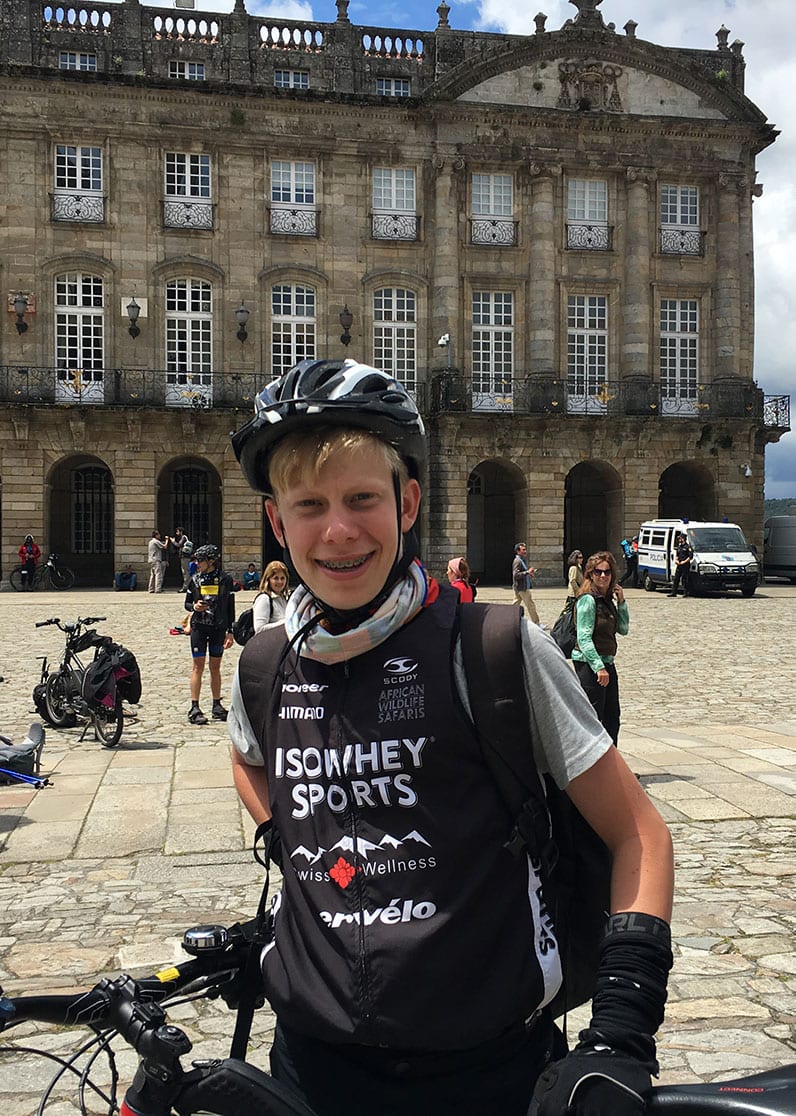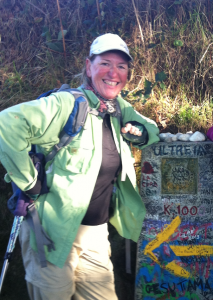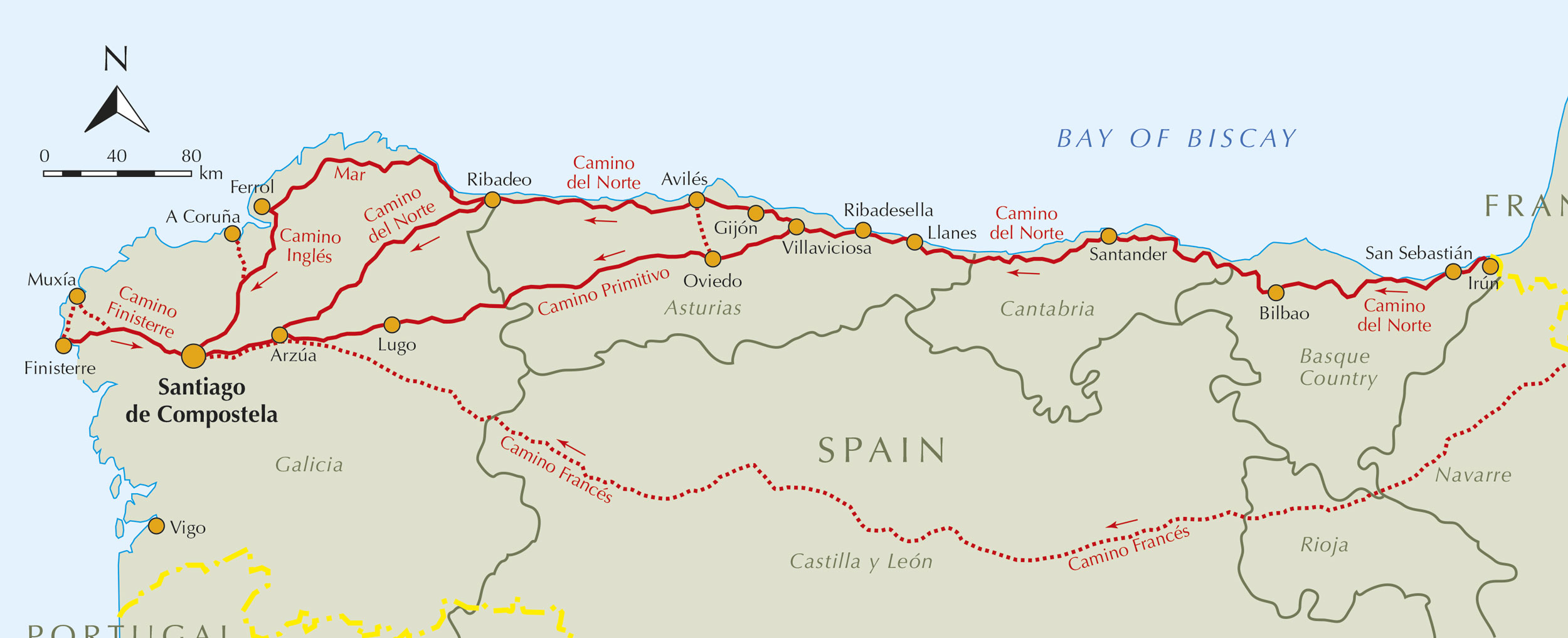Swap two feet for two wheels and ride the famous Camino de Santiago across Spain. The incredibly rewarding, 790-kilometre journey will have you cycling over mountains, through rural villages and across seemingly endless flat plains towards Santiago de Compostela and its magnificent cathedral.
Camino de Santiago: Cycling the French Way
18 days / Self-guided cycling
St Jean Pied de Port to Santiago de Compostela
Cycling the French Way
TRIP STYLE
DURATION/LENGTH
18 days/790 kms
DATES
Any date to suit you
START/END POINT
St Jean Pied de Port to Santiago de Compostela
GRADING
Moderate
PRICE P/P TWIN SHARE
From EURO 2,070 / AUD 3,335

Cycling the French Way of the Camino de Santiago is a tremendous experience. You’ll begin in St Jean Pied de Port, on the French side of the Pyrenees, with a quad-busting ascent in spectacular surrounds. From the top of the mountains – where you’ll cross into Spain – the cycling ranges from flat roads to rolling hills to more mountain peaks. You’ll pass through both tiny villages and large cities like Burgos and Leon, where you have the option of resting up and exploring on foot for a change. Food and wine are a highlight, of course, with local specialities varying along The Way, while the Rioja region offers plenty of opportunities to visit world-class wineries.
Day 1 | Arrive in St Jean Pied de Port
Welcome to St Jean Pied de Port, a bustling market town at the foothills of the French Pyrenees. This is both the natural border between France and Spain and the traditional starting point for the Camino Frances, an 800-odd-kilometre pilgrimage to Santiago de Compostela. While most choose to walk, you’ll be seeing the path to Santiago from the saddle, a completely different perspective with much of the same emotional weight. Over the next three weeks, you can expect to make lifelong connections, witness incredible natural beauty and learn many stories about the history of the pilgrimage and those that walk it.
Day 2 | St Jean Pied de Port – Zubiri | 49 km | Level 4–5
Your journey begins with a tough and challenging climb over the Pyrenees, though the effort is worth it for the stunning panoramic views. Roncesvalles, a settlement on the Spanish side of the range, is a welcome sight and perfect for a meal and drink on one of the many outside tables. This is where many walking pilgrims will spend their first evening, but you’ll push on to the lovely town of Zubiri, which is mostly downhill from Roncesvalles.
Day 3 | Zubiri – Puente la Reina | 49 km | Level 3–4
Leaving Zubiri after breakfast, you’ll cycle through the famous city of Pamplona, known for the San Fermin Festival and its running of the bulls, which is held annually in July. It’s one of Spain’s culinary capitals and there’s an almost overwhelming amount of choice when it comes to tapas bars and restaurants. Be sure to fuel up because the stage out of Pamplona involves some uphill to the Monument of the Pilgrim, which will provide you with fantastic views of the landscape. Puenta la Reina is your final destination, known as the ‘Crossroads of the Ways’ thanks to the intersection of the Aragonese and French ways.
Day 4 | Puente la Reina – Logrono | 72 km | Level 3–4
Leaving Puente la Reina in the morning, you’ll cycle through the beautiful town of Estella with its lovely river and cobbled streets. It’s definitely worth stopping here for a coffee, while a few kilometres further on you’ll find a wine fountain constructed for passing pilgrims back in 1991. You’re welcome to help yourself, but we do encourage restraint as there’s still plenty of riding until Logrono! Luckily, when you do arrive in Logrono after the longest day so far, there are myriad tapas bars and restaurants to try some Rioja wine and local specialities. This is, after all, the capital of the La Rioja region, famous across the world for its red wines.
Day 5 | Logrono – Santo Domingo | 50 km | Level 3–4
Riding out of Logrono, you’ll encounter relatively flat roads on the way to Najera. There are some nice cafes to stop at by the river, perfect for a quick coffee and tortilla, before continuing to the enchanting town of Santo Domingo. This town is celebrated along the Camino de Santiago and there are plenty of local legends surrounding the ancient pilgrimage. If you’re up for a treat – and you surely deserve one – head to the verandah of the nearby parador hotel for a pre-dinner glass of bubbling cava.
Day 6 | Santo Domingo – Burgos | 71 km | Level 3–4
A long, rewarding day in the saddle awaits as you ride from Santo Domingo to Burgos. A perfect place for a break is Belorado, a small town with just over 2,000 inhabitants, which belongs to the Province of Burgos. Continuing the journey, magnificent scenery awaits as you pass through the archaeological site of Atapuerca. Depending on the time of year, the rolling hills of the surrounding landscape may well be a verdant green, guiding you all the way to Burgos.
Day 7 | Optional rest day in Burgos
Burgos, a medieval city, has many historical landmarks including a magnificent, World Heritage-listed cathedral. There are markets, plenty of bars and restaurants, interesting sights and it really is a great spot to spend a couple of nights. We recommend enjoying a rest day here to soak up the atmosphere and if you don’t feel up to exploring, there are some fantastic spots along the river to rest up with a picnic and a good book.
Day 8 | Burgos – Fromista | 68 km | Level 3–4
Setting out from Burgos, the next major village is Hornillos and the journey involves an enjoyable 19-kilometre cycle through open plains. This section of the Camino de Santiago, as it approaches the unbelievably flat Meseta region, is typified by the quiet sounds of nature and endless fields stretching out into the distance. It’s dotted with sleepy villages, ancient churches and divine moments of serenity as you cycle towards the horizon, eventually arriving in the little village of Fromista.
Day 9 | Fromista – Sahagun | 59 km | Level 3–4
You’re well and truly cycling on the Meseta now, coasting along flat, easy roads towards the city of Leon. This is a magical section of the Camino de Santiago, with many people describing it as their favourite due to the unique, almost other-worldly landscape. The views are infinite, stretching to the mountains in the far distance, while the towns are more spread out than in other sections. Your evening’s destination is Sahagun, a quiet town named after Bernardino de Sahagun, known for his devotion to missionary work during the 16th century.
Day 10 | Sahagun – Leon | 55 km | Level 2–3| Optional rest day in Leon
Cycle today through the medieval town of Puerta del Castillo, where there are plenty of temptations for those pilgrims with a sweet tooth, as well as Mansilla de la Mulas. Before you do, however, you can’t miss Bar Elvis in the tiny town of Reliegos, which is a great pit stop for a cold drink before finishing off the journey to Leon. The cycling continues to be flat today, with the mountains approaching on the other side of Leon.
Leon is a wonderful city and it’s definitely worth spending an extra day and night here. The city combines stunning historical architecture with an irresistible energy and its standout attraction is the cathedral, which is one of the most beautiful in Spain. The Rose Window is simply breathtaking. The walled Old Town is very well preserved and the winding alleys and little plazas are incredibly atmospheric. The oldest church in Leon has Vespers every evening and, despite the service being solely in Spanish, it’s worth a visit just to hear the choir made up of nuns.
Day 11 | Leon – Astorga | 54 km | Level 2–3
Cycling west towards the mountains and Astorga, you’ll ride through glorious scenery before entering the village over a quaint bridge. Perfectly positioned on a hilltop, Astorga is known for the Bishop’s Palace, an impressive cathedral that was designed by the famous Antoni Gaudi. The town itself lives up to the cathedral’s design, with some lovely architecture and tasty restaurants offering up local specialities. Be sure to try ‘mantecadas’, a local speciality that’s a cross between a muffin and a scone. We recommend buying a few to keep your energy levels up for tomorrow’s ride.
Day 12 | Astorga – Ponferrada | 53 km | Level 3–4
Cycle out of Astorga and attack the hills up towards Foncebadon and the Cruz de Fierro, taking a moment to pause at one of the most magical places on the Camino de Santiago. Pilgrims often carry a stone from home, which represents a burden, and place or throw it at the base of this iron cross, symbolising the casting off of their worries. There are a few theories as to the origin of the cross, with many believing that a hermit named Gaucelmo, who dedicated his life to protecting pilgrims, first placed it on top of the hill. From here, continue to Ponferrada, which was settled by the Templars many centuries ago. The Castillo de los Templarios, a castle built by the Templars, is a particularly interesting sight.
Day 13 | Ponferrada – O Cebreiro | 53 km | Level 4–5
A memorable day in the saddle awaits as you depart Ponferrada in the morning. With views of rolling hills along the Camino, you’ll cycle through rural villages before reaching the long uphill climb to the magical village of O Cebreiro. This village wouldn’t exist without the Camino and the Camino wouldn’t exist without O Cebreiro – it’s a beautifully symbiotic relationship. After making it to the summit, take some time to catch your breath while appreciating the amazing views over the surrounding mountains. Then it’s time to explore the village. The majority of buildings are stone huts with straw roofs, some of which will be serving traditional Galician stew, fresh cheese drizzled with honey and, of course, Galician-style pulpo (octopus). Eat up!
Day 14 | O Cebreiro – Portomarin | 62 km | Level 3–4
This morning will no doubt be a highlight of your journey as you sail down the mountains from O Cebreiro. The views will stay in your memory for a lifetime and, once you’ve reached the bottom, the route mainly passes through fields and small villages before reaching the hill of San Roque. Here you’ll find a statue of a pilgrim making his way to Santiago, just the encouragement needed for the final push to Portomarin. This town, which is reached via an impressive bridge spanning the river, is known for its tarts and liqueurs and there are plenty of great dining options.
Day 15 | Portomarin – Arzua | 53 km | Level 3
The penultimate day of your cycling journey along the Camino de Santiago will see you weaving through farming regions pass fields of sunflowers. Your destination is Arzua, which is famous for its tasty local cheese. There are a couple of lovely churches to visit too. Tomorrow you’ll ride to Santiago de Compostela, so be sure to take a moment to appreciate your final day on the pilgrimage. Share stories, break bread, drink wine – there’ll be anticipation in the air.
Day 16 | Arzua – Santiago de Compostela | 39 km | Level 3–4
An exciting and memorable day awaits as you pedal the final kilometres to Santiago de Compostela. This special city has a particular magic that can only be enjoyed by spending time in its atmospheric streets. You’ll catch sight of the famous cathedral’s spires from a distance, then it’s smooth sailing – or riding – into the city centre through its outskirts. Take a moment outside the cathedral to reflect on your cycling pilgrimage thus far, then collect your compostela certificate from the pilgrim’s office. In the evening, hit the streets of Santiago for tapas, octopus, wine and more. There’s always an energetic mix of locals and pilgrims, making this city the perfect place to celebrate.
Day 17 | Suggested extra day in Santiago de Compostela
Enjoy a free day in Santiago, soaking up the atmosphere as pilgrims arrive from all over the country. A day trip to Finisterre, which was once considered ‘the end of the world’, is a fantastic idea, with buses running to and from Santiago. Take your bathing suit for a refreshing swim, perhaps trekking up to the lighthouse for a memorable sunset over the Atlantic Ocean.
Day 18 | Finish in Santiago de Compostela
Your cycling pilgrimage officially comes to an end after breakfast this morning.
Visit www.wanderingtheworld.com.au for more information.
Inclusions
- 17 nights accommodation, all carefully selected to enhance your Camino experience
- Private en-suite facilities
- Daily breakfast
- Information packs with route maps and instructions on how to locate hotels
- Pilgrim’s passport
- Emergency contact details and 24/7 local on-the-ground support
- Pre-departure and ongoing support from Australian office
Optional Inclusions
- Three-course dinners with local wine
- Daily luggage transfers from hotel to hotel (1 x 20kg bag unless indicated otherwise)
- Bike hire (27 speed BTT, plus repair kit, pump, lock & water bottle holder)
- Bike accessories – panniers (front and rear), bike seat gel cover, toe clips, helmet
- Suggested rest days as outlined in itinerary or if required
- Upgraded accommodation including paradors, country properties and premium/high-end styles
- Private vehicle transfers to the trip’s starting point
- Single supplement for your own room
- Additional night’s accommodation before or after trip (please advise at time of booking)
Not Included
- Flights
- Travel to trip’s starting point
- Transfers not already outlined in detailed trip itinerary
- Lunches
- Dinners
Accommodation
We know from personal experience that a good night’s rest can make or break a trip, which is why we carefully hand-select all our accommodation. We ensure that our knowledge and firsthand experience of the best places to stay is passed on to all our cyclists.
Your accommodation along the Camino is booked in advance, on a twin-share basis with private facilities, and chosen to make your journey as rewarding as possible. You may be staying in a refurbished farmhouse, some of which have been in the same family for centuries, or perhaps a boutique hotel with a chef who would not be out of place in a Michelin-starred restaurant. There are unique properties scattered throughout the different routes including converted monasteries, lighthouses and tiny B&Bs with the most generous hosts you could possibly imagine. Best of all, you’ll always have private en-suite facilities. Wherever you end up, you’ll be well looked after, warm and comfortable and, most importantly, ready to tackle the next day on your bike.
Single supplements are also available so you can enjoy your room with private en-suite. This supplement will apply if you are travelling alone or if there is no gender-share option. You can request a shared room through Wandering the World at the time of booking, however this is not guaranteed.
There are opportunities to upgrade to more luxurious lodgings in many places along the Camino. These are perfect for celebrating special occasions and milestones, or even to enhance your entire journey. We can recommend some very special, unique places to indulge in the Camino hospitality in spectacular style, so please ask us about these options when booking.
Food & Dining
The local cuisine is a definite highlight of your walk. The Camino regions are famous for their culinary delights, and you’ll end up exploring the destination using not only two wheels, but also your taste buds.
Breakfast at your place of accommodation is usually continental style and may include cereals, yoghurt, bread, pastries, ham, tea, coffee and juices.
Lunch – at your own expense – will depend on where you are on your walk and what is available. It’s often purchased at a local café or bar, with choices along the trail perhaps including Spanish omelette (tortilla Espanola), tuna empanadas, soups or sandwiches (boccadillo). Alternatively, you may wish to enjoy a picnic in a perfect spot along the path.
Evening meals are a hearty, three-course affair known as the ‘pilgrims’ menu’. These usually consist of a salad or soup to start, followed by a choice of a meat or pasta dish, then finishing with a dessert. This is always accompanied by a bottle of local wine, of course. On occasion, the owner of the accommodation may be in the kitchen preparing the house special, which will not disappoint.
Most evening meals are included on guided group trips, and for self-guided itineraries Wandering the World can include as many evening meals as you wish. We may strongly recommend this in some places because it’s either been a long day or there are limited choices available in certain destinations. We can share our advice and talk to you about this at the time of booking. We can accommodate most dietary requirements, so please let us know in advance.
THE CYCLING
This trip is a self-guided itinerary, ideal for groups and independent travellers who prefer to navigate in their own way and their own time.
You will be provided with an information pack including easy-to-read maps and instructions, complete with directions to guide you on the well-marked paths and tracks. On the Camino, you will be following the yellow arrows or the assigned roads and Camino scallop shells, while the Chemin is marked with red and white stripes, or directions to rural bike paths. This information pack will be available at your joining hotel on the first day of your trip.
TRIP GRADE ABOUT THIS CYCLING HOLIDAY
General difficulty: 3-5 (see the level of difficulty in each stage).
Level 1: mainly flat, without big slopes.
Level 2: small slopes, dirt roads.
Level 3: moderate slopes, dirt roads, sometimes challenging.
Level 4: big slopes, narrow tracks, challenging, sometimes rocky.
Level 5: big slopes, sometimes very difficult paths, paths over rocks.
LUGGAGE TRANSFERS – OPTIONAL
Wandering the World arranges a daily luggage transfer to maximise your comfort and enjoyment, or you can choose the option of a pannier rental to carry your own luggage if you wish. The luggage transfer allowance is one bag per person of no more than 20 kg (13 kg on the Chemin). Your luggage must be left in the reception of your hotel before breakfast (8 am) each day.
Please note:
- It is essential to attach the bag tag provided to ensure your luggage is delivered to your next accommodation.
- Only one bag will be moved each day and additional charges will apply if your bag is heavier than 20 kg (13 kg on the Chemin).
- Should you require special arrangements for additional luggage transfers, these can be made ahead of time and must be paid as part of your final payment to Wandering the World.
GROUP SIZE
Wandering the World’s guided groups have a maximum group size of 12 participants. This small group size means that we have the flexibility to stay in a wider range of accommodations, can dine together in the evenings, have the freedom to walk alone or together, and there are more opportunities to get to know your travelling companions.
WEATHER
The weather and climate on the Camino can vary from country to country, region to region and, of course, from day to day. Each season has its own benefits, with long, warm and sunny days in spring and early summer, while early spring and late autumn tend to enjoy cooler walking temperatures. Some sections may be too hot for walking mid-summer, while others are more likely to be wet at certain times. The experts at Wandering the World can discuss your preferences and guide you when you are planning your trip.
Once you’ve started your walk, the weather can play an important role in your overall enjoyment of the journey. Checking the forecast can be a great help when planning your days. If you do strike hotter weather, leaving early to avoid the warmest part of the day will make a huge difference.
24/7 SUPPORT & CARE
Your information pack will include details of local emergency contacts and international contacts. We have local, on-the-ground support to provide any assistance you may require and we’ll also check-in with your hotel at the end of each day to ensure that you’ve arrived safely.
GETTING THERE / GETTING HOME
This itinerary begins in Saint John Pied de Port and ends in Santiago de Compostela.
The closest airports to Saint John Pied de Port are Madrid, Barcelona, Biarritz, Pau or Bordeaux.
From your airport of choice there are bus, train and flight options as per the links below.
Train bookings are recommended. Please note you can only book two months in advance of the date of travel.
Bus: ALSA
Train:
Bus/Train : Rome2Rio
Flights:
Also, check out: Skyscanner OR Spanish Airport Guide
From Santiago de Compostela
You can catch the shuttle bus from Santiago city centre to the airport. Bus also stops at the bus station (Estación de Autobuses) and the train station (Estación de Ferrocarril). For more information go to www.empresafreire.com
If you wish to travel to Porto Airport there is a direct bus from Santiago once or twice a day (approx 4-6 hrs). More information available here www.alsa.es
INSURANCE
Insurance is compulsory for everyone who travels with Wandering the World. The insurance policy must include cover against personal accident, medical expenses, emergency repatriation and personal liability. Wandering the World recommends insurance coverage for cancellation to be taken at the same time your deposit is paid, as no exception to the cancellation provisions can be made.
BOOKING AND TRAVEL TERMS AND CONDITIONS
Wandering the World’s full booking terms and conditions are available upon request and will also accompany your initial invoice for deposit.
 “Although I have chosen to walk 24 Caminos including the entire path from St Jean Pied de Porto through to Santiago de Compostela and onto Finisterre, I am still familiar with cycling in Europe and have thoroughly enjoyed the challenge on two wheels. One important consideration for choosing to cycle over a walk on the Camino is the degree of difficulty if you are not a cyclist. There are challenges particularly if you plan to start at the base on the Pyrenees and take on the mountains through to Pamplona. The shorter distances from Burgos, Leon or Porto on the Portugal Camino are less confronting, however I highly recommend only the experienced cyclists to take to the bike and others to stick with the walking”. – Glenyce, Founder of Wandering the World.
“Although I have chosen to walk 24 Caminos including the entire path from St Jean Pied de Porto through to Santiago de Compostela and onto Finisterre, I am still familiar with cycling in Europe and have thoroughly enjoyed the challenge on two wheels. One important consideration for choosing to cycle over a walk on the Camino is the degree of difficulty if you are not a cyclist. There are challenges particularly if you plan to start at the base on the Pyrenees and take on the mountains through to Pamplona. The shorter distances from Burgos, Leon or Porto on the Portugal Camino are less confronting, however I highly recommend only the experienced cyclists to take to the bike and others to stick with the walking”. – Glenyce, Founder of Wandering the World.

Every day was a different experience. From rocky dirt tracks, steep mountain roads, or quiet forest to cobbled stoned villages, cycling the Camino was certainly an adventure. Add magnificent views, great food & wine & the camaraderie of other cyclists & walkers – it certainly was a special journey.
Kath S, Cycling the Camino, 2018
